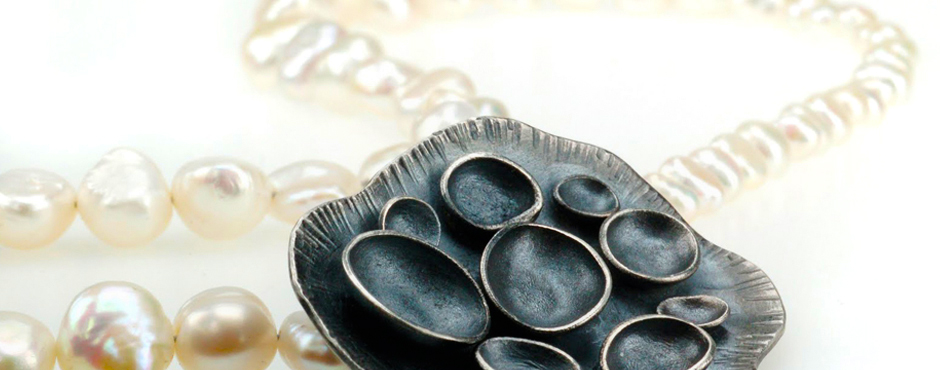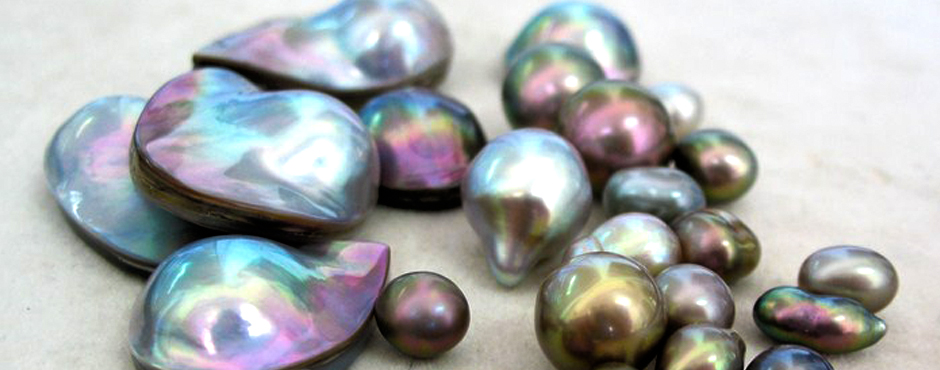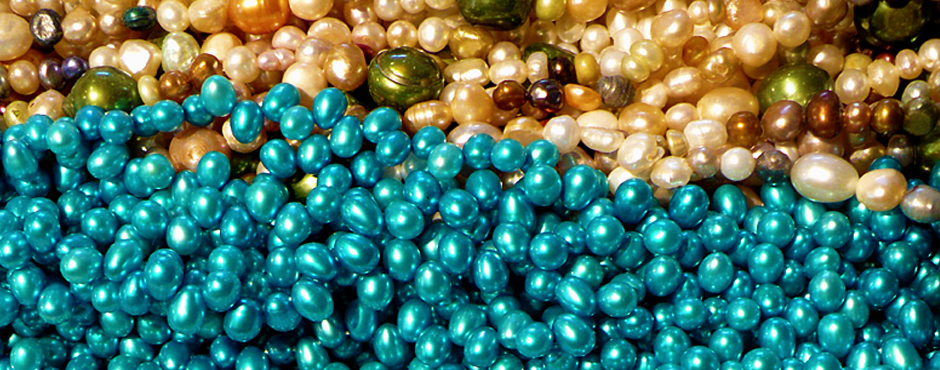Pearls
Cultured pearls are precious jewels and should be treated as such. They're also the products of living creatures. Cultured pearls are formed when an irritant is introduced into a mollusk. The mollusk secretes a substance called nacre, which covers the irritant and produces the pearl. Nacre gives pearls the rainbow of colors and luster that makes these gemstones so treasured, but its delicate nature also makes pearls particularly susceptible to damage. For this reason you should be extra careful with your cultured pearl jewelry.
A timeless gem, enjoyed equally in ancient Rome or modern America, pearl is a favored jewel of women around the globe. So valued are they, that on his third voyage to the Americas, Columbus kept his discovery of pearls in the New World a secret, and fell out of favor with the King of Spain. In the Orient, pearl powders are sold as an aphrodisiac. Pearls are unique in that they are the only gem of the sea from living creatures requiring no faceting or polishing to reveal their natural beauty. In the early 1900s the first successful commercial culturing of round pearls began. Since the 1920s cultured pearls have almost completely replaced natural pearls in the market. Cultured pearls are cultured and harvested in Japan, China, South Seas including Tahiti, Australia, Burma, the Philippines, and the United States. Cultured pearls are an essential part of every sophisticated woman's complete jewelry wardrobe and can be cherished for generations to come. In fashion, pearls offer many exciting accessorizing opportunities including pendant enhancers, pins, strand shorteners, and interchangeable gemstone clasps.
Composition of Cultured Pearls
The iridescent layer inside some species of shells is called "Mother-of-Pearl." When these layers accumulate on the implanted nucleus (made from shell) it is called "nacre" (nayker). The finer, thicker and more uniform the nacre is, the more lustrous and blemish-free the pearl forms, and therefore it is more valuable and desirable.
The Pearl Culturing Process
At an age of two to three years (Japan) and four to five years (South Seas), the oyster is implanted with a round nucleus of mother-of-pearl that is left inside for one to three years. After much tender-loving care, the oysters are harvested. Fine quality cultured pearls are extremely rare. Only 25 to 50% of the crop produces a pearl, and fewer than 5% are of export quality. Environmental factors such as pollution, natural predators and adverse weather over the considerable time it takes to raise oysters, seed them, and nurture the crop until harvest should give one an appreciation for man and mother nature working closely together to produce these wonders of the sea.

Varieties & Types of Cultured Pearls
Freshwater Pearls
Originating in lakes, rivers, and streams, these pearls are generally "baroque" or freeform in shape, and come in a multitude of colors, sizes, and shapes. China is the largest producer of these pearls. The United States also produces many freshwater pearls. An important high-quality producer in the past was Lake Biwa in Japan.
Three-Quarter Pearls
These are cultured pearls that are flat on one side and are ideally suited for earrings, pendants, and rings. Since they are not round, they are much more affordable, and are set such that the client has the full benefit of a much larger appearing pearl.

Mabe Pearls
This fashionable, and affordable larger-sized assembled pearl product is constructed from a blister pearl (resembling an egg-shell) harvested from the magnificent mabe, or butterfly-shaped shell. This blister pearl is attached to a flat base of mother-of-pearl and filled with a solid mother-of-pearl bead and a special bonding agent. The final result is a larger cultured pearl product in a variety of shapes with a flat back perfect for earrings and pendants. Mabe pearls offer a fashion-forward look, in a larger size at a very economical price.
Japanese Pearls
Much of the world's round cultured pearls under 10 mm are harvested in Japan. These pearls are typically white, light cream, silver-gray, and rarely pink in color. Japanese pearls are known for their smooth texture and high luster.
South Seas Pearls
A marvelous array of larger cultured pearls, usually over 10 mm, from rounds to drop shapes, barrels, rosebuds, and symmetrical shapes in a variety of colors are produced. Black pearls are cultured in Tahitian oysters. Other species of shell typically produce cream colors, and more rarely white and silver-gray shades. Considering the extreme rarity of South Seas oysters, and the older ages of the oysters at nucleation, the largest, finest strands of these pearls may take years to assemble, the pearls matched from among thousands of beads. These strands can command from tens of thousands up to over a million dollars in value.
The Value Factors for Cultured Pearls
Size
Three things determine the size of a cultured pearl; size of the mother-of-pearl nucleus, size of the oyster, and thickness of the nacre. Size is an important value factor. Certain sizes that are in fashion demand, may command premium prices. Supply and demand are the over-riding factors.
Shape
Among connoisseurs, the more perfectly round a pearl is, the more valuable and desirable it becomes. Pearls today are offered in a fascinating array of shapes and sizes.
Color - Three Components
Pearl color includes: the body color (the primary color - either light, dark, or colored), the overtone color (a tint that appears super-imposed on the body color), and a rare component called orient (an iridescent, or rainbow of colors that generally is found on baroque pearls, or those with an irregular surface). The most valuable pearls in the light body color group are pink, pink rose and white rose with a very high luster, and are well matched, and round, with a clean surface. The finest dark pearls are black with a metallic green overtone color. Pearls also come in pastel colors such as: pink, purple, yellow, golden, green, silver, and blue. The most valuable overtone color in light pearls is rose. The color of the "mother-of-pearl" inside the shell determines the pearl color, depending on the species.
Luster
Of the value factors, luster is among the most important. Luster refers to the quality and quantity of light reflecting from the pearl's surface, or "brightness" of the pearl. Very high luster is a sign of fine quality nacre, and is found only in the rarest pearls that command a premium price. Japanese pearls, in general, exhibit a higher luster than South Sea varieties which show a softer, more velvety appearance.
Surface Texture
This feature refers to the degree of surface perfection. Finer quality nacre is very smooth, and nearly blemish-free, however, most pearls have natural surface characteristics that serve to identify them and act as "Mother Mature's" fingerprints. The cleaner the surface, the higher luster produced, and more valuable the pearls become.
Nacre Thickness
Top quality cultured pearls have thick layers of very finely accumulated nacre that produce a magnificent luster, and durable pearl. Japan has strict export standards regarding nacre thickness to ensure a quality product worldwide.
Matching - Blending
When multiple pearls are combined, the quality of matching them such as in earrings is an important factor. In selecting pearls for a strand, the pearls are closely blended for all of the features presented here. in all strands the closest matching, finest quality pearls are found in the front third of the strand.

Cultured Pearl Enhancements
Most cultured pearls are subjected to bleaching as a normal part of the processing phase of the gem to whiten and brighten the nacre. Some cultured pearls are dyed to produce a number of dynamic fashion looks.
Precious Metals Market Prices
![]() Precious metals are rare, naturally occurring elements of high value.
Precious metals are rare, naturally occurring elements of high value.
Certifications
 The BBB Code of Business Practices represents sound advertising, selling and customer service practices that enhance customer trust and confidence in business.
The BBB Code of Business Practices represents sound advertising, selling and customer service practices that enhance customer trust and confidence in business.

